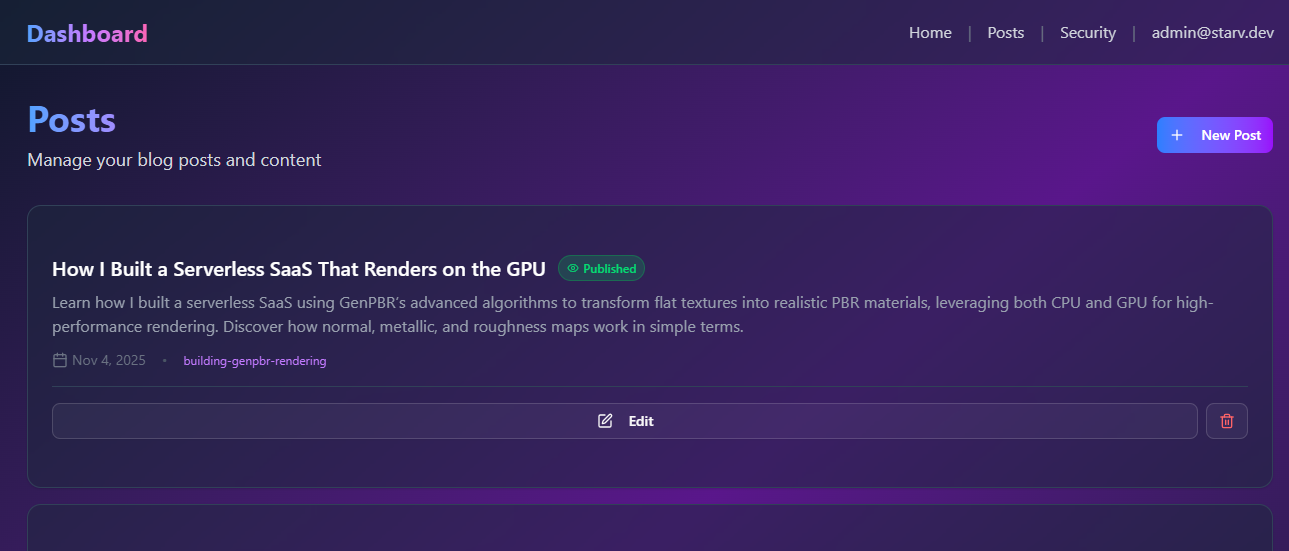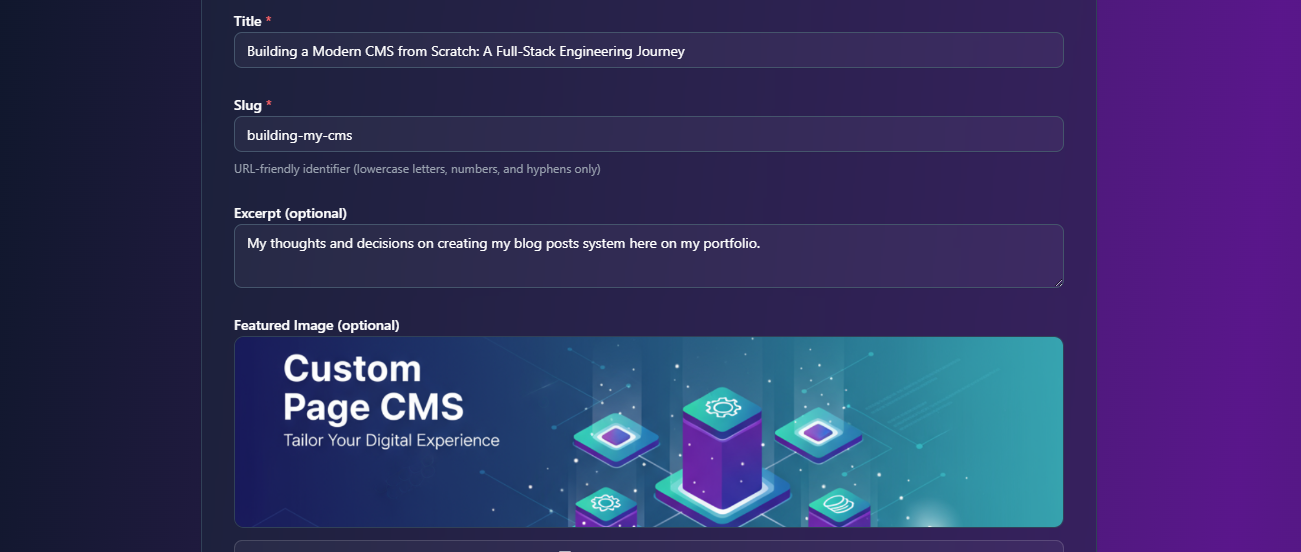Building a Modern CMS from Scratch: A Full-Stack Engineering Journey

My thoughts and decisions on creating my blog posts system here on my portfolio.
Building a Modern CMS from Scratch: A Full-Stack Engineering Journey
When I set out to build my personal portfolio and blog, I faced a common dilemma: use an off-the-shelf CMS like WordPress or a headless solution like Contentful, or build something custom that perfectly fits my needs? As a full-stack engineer who loves solving problems, I chose the latter. Here's how I built a production-ready content management system from the ground up using modern web technologies.
Why Build a Custom CMS in 2025/2026?
Before diving into the technical details, let me address the elephant in the room: why build a custom CMS when there are so many great options available?
The answer comes down to three key factors:
Control and Flexibility - Every feature is exactly what I need, no bloat, no unnecessary complexity. I'm not paying for features I'll never use or wrestling with plugins that almost do what I want.
Performance - By building on Next.js 16 with the App Router and implementing smart caching strategies, I achieved sub-second page loads without relying on third-party services.
Learning and Ownership - As an engineer, there's immense value in understanding your entire stack. Plus, I own my data completely—no vendor lock-in, no surprise API changes, no monthly fees scaling with my success.
The Tech Stack: Modern, Efficient, Scalable
I built this CMS using a carefully selected stack that balances developer experience with production performance:

Frontend Layer
Backend & Database
Content Features

Architectural Decisions That Matter
Smart Caching with Incremental Static Regeneration
One of the biggest challenges with any CMS is the balance between fresh content and fast performance. Static sites are blazingly fast but require rebuilds. Fully dynamic sites are always fresh but slower.
I implemented Next.js's Incremental Static Regeneration (ISR) with a 60-second revalidation window:
export const revalidate = 60;This means:
For the API routes that power the dashboard, I used force-dynamic to ensure administrators always see the latest data:
export const dynamic = 'force-dynamic';
export const revalidate = 0;Server Components vs Client Components
Next.js 13+ introduced a paradigm shift with React Server Components. I leveraged this architecture to optimize performance:
Server Components handle:
Client Components only for:
This separation means the initial page load is minimal JavaScript, improving performance significantly, especially on mobile devices.
Database Schema Design
I kept the database schema simple but extensible:
posts: {
id, title, slug, content, excerpt,
published, authorId,
createdAt, updatedAt, deletedAt
}
users: {
id, email, passwordHash, name,
createdAt, updatedAt, deletedAt
}The soft delete pattern (deletedAt) allows content recovery and maintains referential integrity. The excerpt field enables SEO-friendly meta descriptions without parsing the full content.
Features That Enhance the Writing Experience
Real-Time Markdown Preview
As a developer, I love Markdown for its simplicity. But constantly switching between editor and preview is tedious. I built a toggle preview mode that renders content exactly as it will appear on the published site:
Intelligent Content Toolbar
While Markdown is great, not everyone remembers the syntax. The toolbar provides one-click formatting:
Each button intelligently wraps selected text or provides a template at the cursor position.
Word Count and Reading Time
Writers need metrics. The dashboard automatically calculates:
These update in real-time as you type, helping with content planning and SEO optimization.
URL Slug Management
SEO-friendly URLs are crucial. The system automatically generates clean slugs from post titles:
"Building a Custom CMS" → "building-a-custom-cms"
"10 Tips for Better Code!" → "10-tips-for-better-code"You can also manually edit slugs with validation to ensure they remain URL-safe (lowercase, alphanumeric, hyphens only).
Reader Experience Optimizations
Building a great CMS isn't just about the admin experience—the reader experience matters just as much.
Reading Progress Indicator
A gradient progress bar at the top of each post shows reading progress. It's smooth, non-intrusive, and helps readers gauge article length at a glance.
The implementation uses efficient scroll event handling with proper cleanup to avoid memory leaks.
Social Sharing Integration
Every post includes:
This increases content reach without relying on heavy third-party widgets.
Author Profiles
Each post displays author information with a professional bio section, including a profile image. This humanizes the content and improves E-E-A-T (Experience, Expertise, Authoritativeness, Trustworthiness) signals for SEO.
Enhanced Typography
I paid special attention to readability:
SEO Optimization Built-In
Search engine optimization is baked into every layer:
Metadata Generation
Each post automatically generates:
Structured Data
I implemented comprehensive schema.org markup:
{
"@type": "BlogPosting",
"headline": "Post Title",
"author": {"@type": "Person", "name": "..."},
"datePublished": "...",
"dateModified": "...",
"publisher": {...}
}This helps search engines understand content context and enables rich search results.
Performance Metrics
Fast sites rank better. This CMS delivers:
The Dashboard: Where It All Comes Together
The admin dashboard is clean, intuitive, and powerful:
Security Considerations
Even for a personal blog, security matters:
Deployment and Infrastructure
The entire system deploys to Vercel with zero configuration:
Database hosting on a managed PostgreSQL provider ensures reliability without the operational overhead.
Lessons Learned and Future Improvements
What Went Well
Building this CMS taught me invaluable lessons about full-stack architecture:
What I'd Do Differently
Every project has room for improvement:
Roadmap
Future enhancements I'm considering:
1. Tag and Category System: Better content organization and discovery
2. Full-Text Search: Algolia or PostgreSQL full-text search integration
3. Related Posts: Algorithmic recommendations based on content similarity
4. Newsletter Integration: Email capture and automated sending
5. A/B Testing: Built-in title and excerpt testing for engagement optimization
Performance Benchmarks
Numbers don't lie. Here's how the CMS performs:
These metrics rival or exceed many commercial CMS platforms while maintaining complete control.
Why This Matters for Modern Web Development
This project represents more than just a blog—it's a case study in modern full-stack development:
Modern React Patterns: Server Components, Suspense boundaries, and proper client/server separation showcase Next.js 16 best practices.
Database-Driven Architecture: Moving beyond static-only sites while maintaining performance demonstrates real-world scalability.
Type Safety Throughout: End-to-end TypeScript from database to UI ensures reliability and maintainability.
Performance-First Mindset: Every architectural decision considered speed, from ISR to minimal JavaScript.
Open Source and Learning
The beauty of building your own tools is the learning experience. Every challenge—from implementing reading progress to handling Markdown rendering to optimizing database queries—deepened my understanding of web fundamentals.
Would I recommend everyone build their own CMS? Probably not. But if you're a full-stack developer looking to level up your skills, there's no better teacher than building a production system from scratch.
Conclusion: Empowerment Through Ownership
Building a custom CMS was an investment of time and effort, but the returns have been substantial:
For developers considering a similar journey, my advice is simple: start small, iterate based on real needs, and don't over-engineer. Build what you need today, and extend it as requirements evolve.
The web is built on content, and understanding how to manage, deliver, and optimize that content is a fundamental skill for any modern full-stack engineer. Whether you build your own CMS or use existing tools, understanding the underlying architecture makes you a better developer.
Want to see the CMS in action? You're reading a post created with it right now. All the features mentioned—from the reading progress bar to the share buttons to the structured data—are part of the system.
Have questions about the technical implementation? Feel free to reach out—I love talking about web architecture and engineering challenges.

About Star Vilaysack
Full-stack software engineer based in Minneapolis, specializing in building production-grade web applications. Passionate about web development, cloud architecture, and creating exceptional user experiences.